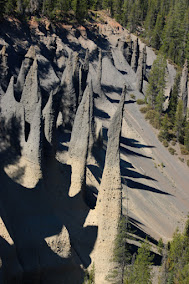Day Three – Prussian Blue
The lake is about six miles in diameter and Wizard Island, off the near shore, is a well-known feature. As we began our day exploring this National Park, we wondered what else would we learn during our stay.
Why so blue? According to park information, the color is due
to two things – depth and cleanliness. Crater Lake is the deepest lake in North
America and is said to be the cleanest large body of water in the world! Formed
when 12,000-foot Mount Mazama erupted 7,700 years ago, the crater eventually
filled with water that is only precipitation and runoff from snow melt. Therefore,
no sediment from river runoff to “dirty up” the lake. In addition, the depth of
the lake absorbs the red, yellow, and green light spectrum from sunlight leaving
only the blue light waves to return to the surface as a brilliant blue.
A side trip which was an after thought, turned out to be a very interesting part of our day in the park. We headed out to see The Pinnacles without knowing what we’d find.
These fossilized fumaroles formed when hot ash from the erupting Mt. Mazama filled a river valley. As the ash cooled, it released steam which vented to the surface. In the process, the combination of minerals in the ash and its heat created very hard material. Erosion of the softer ash over the next 7,000+ years left behind these stone spires along the whole river canyon. It was intriguing to wander along the trail and see more and more of these jagged pinnacles.W hat a unique set of geologic events left behind this
national treasure we call Crater Lake!







Comments
Post a Comment